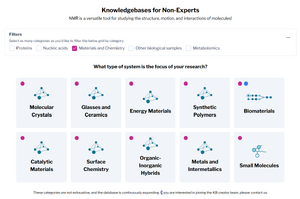Knowledgebases for Non-Experts: Difference between revisions
From Network for Advanced NMR
Jump to navigationJump to search
Mmaciejewski (talk | contribs) No edit summary |
Mmaciejewski (talk | contribs) No edit summary |
||
| Line 38: | Line 38: | ||
If you would like to contribute to these KB Content Areas, please reach out to any of the [https://usnan.org/about/contacts NAN contacts] | If you would like to contribute to these KB Content Areas, please reach out to any of the [https://usnan.org/about/contacts NAN contacts] | ||
Content | == Content Areas == | ||
Each | Each Knowledgebase for Non-Experts is organized into '''Content Areas''', which serve as the primary hubs for exploring how NMR can be applied to specific types of samples or scientific questions. | ||
=== Structure of a Content Area === | |||
* Each Content Area is composed of a series of '''tabs''' across the top of the page. | |||
** Every Content Area includes a tab titled '''Introduction''' | |||
** Some Content Areas also include a tab titled '''What's right for you?''' | |||
*** This tab walks users through a decision tree to help them determine: | |||
**** If their system is suitable for NMR study | |||
**** What types of NMR experiments are appropriate for their needs | |||
=== Components of Each Tab === | |||
Each tab may contain the following elements: | |||
* '''HTML blurb''' | |||
** Provides an overview or educational narrative related to the topic | |||
* '''Links to primary citations''' | |||
** Key references relevant to the scientific subject | |||
* '''Links to related vignettes''' | |||
** '''Content vignettes''' – supplementary pages with in-depth information that does not fit within the main tab layout | |||
** '''Literature vignettes''' – concise summaries of published studies where the topic played a central role | |||
* '''Links to related KB datasets''' | |||
** Direct access to experimental datasets that are well vetted and connected to the subject matter | |||
* '''Optional image''' | |||
** A representative figure or illustration may be included to visually anchor the content | |||
Revision as of 15:57, 17 June 2025
Overview

KBs for Non-Experts are organized into Content Areas, with each content area belonging to one or more filterable high-level categories
Categories
- Proteins
- Nucleic Acids
- Materials and Chemistry
- Metabolomics
- Other Biological Samples
Content Areas
The table below shows the Content Areas separated by their
| Proteins | Nucleic Acids | Materials and Chemistry | Metabolomics | Other Biological Samples |
|---|---|---|---|---|
| Intrinsically Disordered Proteins | DNA | Molecular Crystals | Biomarkers | Biomaterials |
| Soluble Proteins | RNA | Glasses and Ceramics | Flux | Carbohydrates |
| Fibrils and Polymeric Proteins | Energy Materials | Compound Identification | Natural Products | |
| Membrane Proteins | Synthetic Polymers | Systems Biology | ||
| Ligand Binding | Biomaterials | |||
| Catalytic Materials | ||||
| Surface Chemistry | ||||
| Organic-Inorganic Hybrids | ||||
| Metals and Intermetallics | ||||
| Small Molecules |
If you would like to contribute to these KB Content Areas, please reach out to any of the NAN contacts
Content Areas
Each Knowledgebase for Non-Experts is organized into Content Areas, which serve as the primary hubs for exploring how NMR can be applied to specific types of samples or scientific questions.
Structure of a Content Area
- Each Content Area is composed of a series of tabs across the top of the page.
- Every Content Area includes a tab titled Introduction
- Some Content Areas also include a tab titled What's right for you?
- This tab walks users through a decision tree to help them determine:
- If their system is suitable for NMR study
- What types of NMR experiments are appropriate for their needs
- This tab walks users through a decision tree to help them determine:
Components of Each Tab
Each tab may contain the following elements:
- HTML blurb
- Provides an overview or educational narrative related to the topic
- Links to primary citations
- Key references relevant to the scientific subject
- Links to related vignettes
- Content vignettes – supplementary pages with in-depth information that does not fit within the main tab layout
- Literature vignettes – concise summaries of published studies where the topic played a central role
- Links to related KB datasets
- Direct access to experimental datasets that are well vetted and connected to the subject matter
- Optional image
- A representative figure or illustration may be included to visually anchor the content